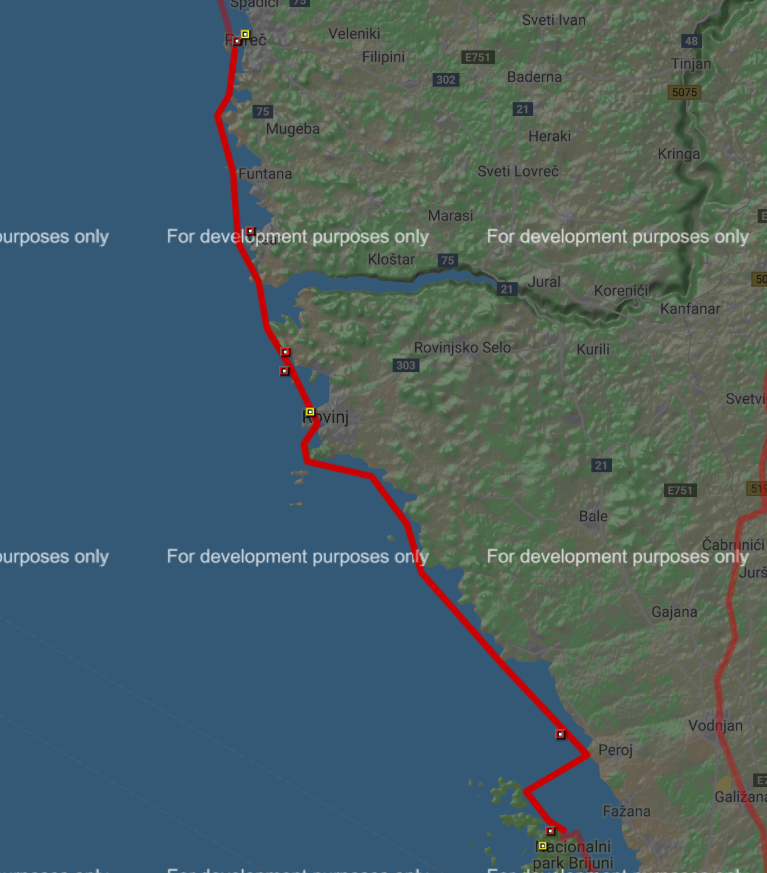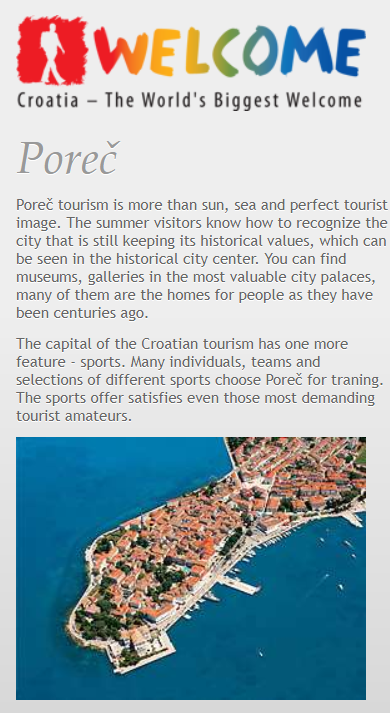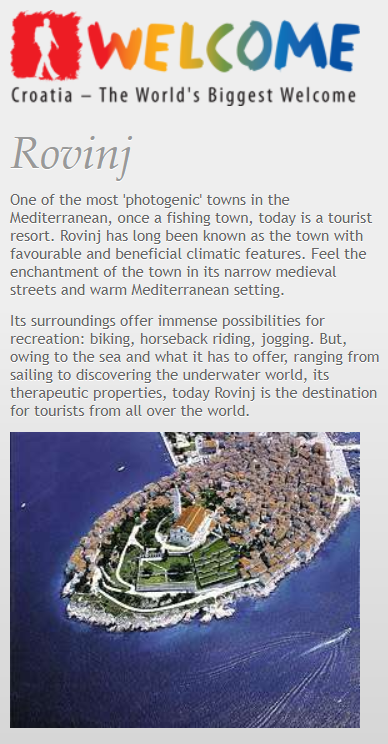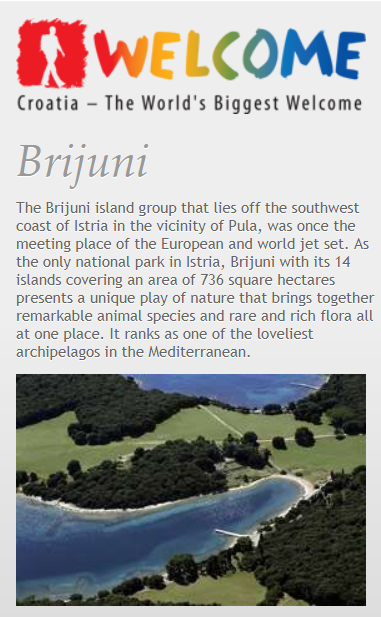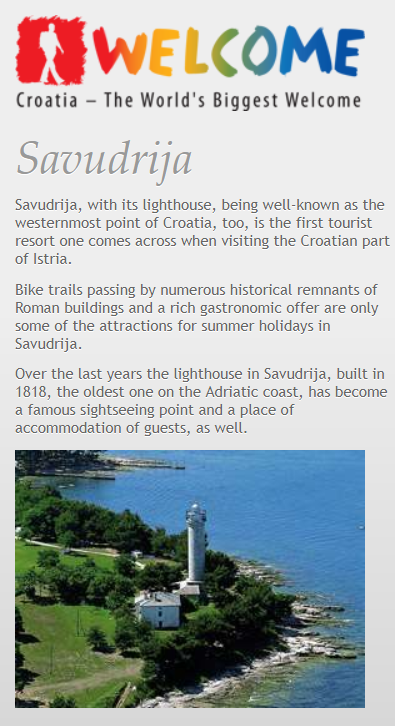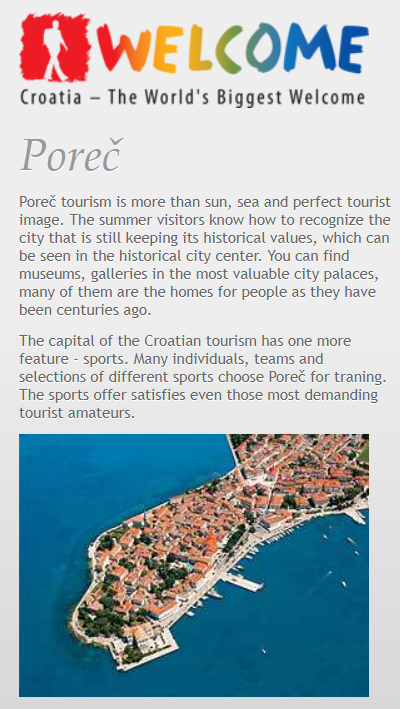World's Biggest Welcome in Croatia: Day 2 - Porec to Brijuni (Kayak)
March 29, 2019 - Putting Croatian adventure tourism on the map, with the biggest welcome in the world. A little kayaking on day 2 from Porec to the Brijuni islands via Rovinj.
An idea to celebrate the extraordinary potential of adventure tourism the length and breadth of the Croatian coast. As TCN explained in the introductory article, back in 2011, Daniel Lacko and his team's vision was to create a route which mapped out on GPS the world Welcome from Savudrija on the border with Slovenia, to Dubrovnik in the south, to showcase the different types of sporting challenge that could be enjoyed in this hospitable tourist nation. Some 2500 km in total.
After a first-day kayak from Savudrija to Porec, day two was also on the water, and it was an early start for Lacko carrying his kayak through the historic streets of gorgeous Porec.
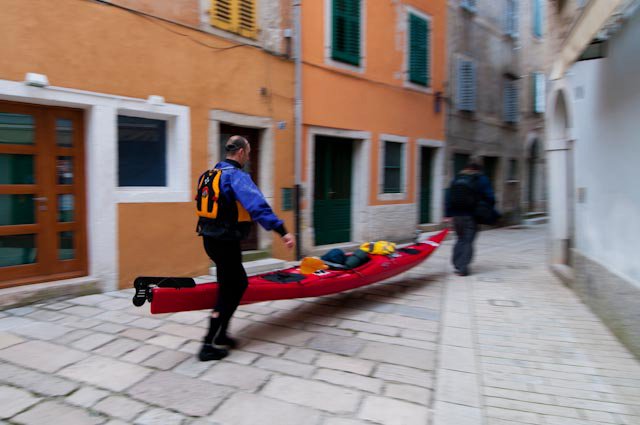
The challenge for Day 2 - 45 km of kayaking from Porec to the Brijuni islands via Rovinj.
There would be many different disciplines on land, sea, lake and river ahead, but the project started with kayaking along the Istrian coast.
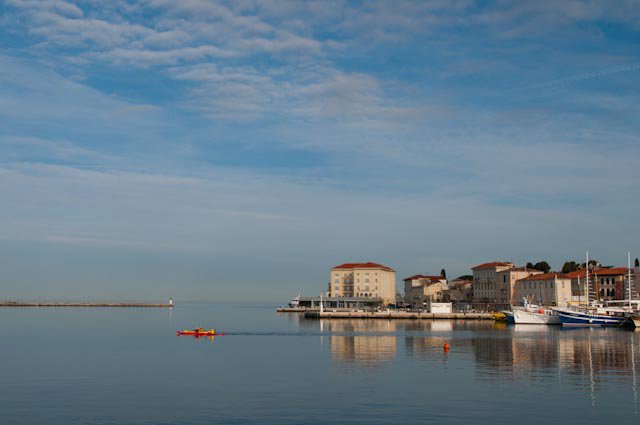
A morning farewell to gorgeous Porec.
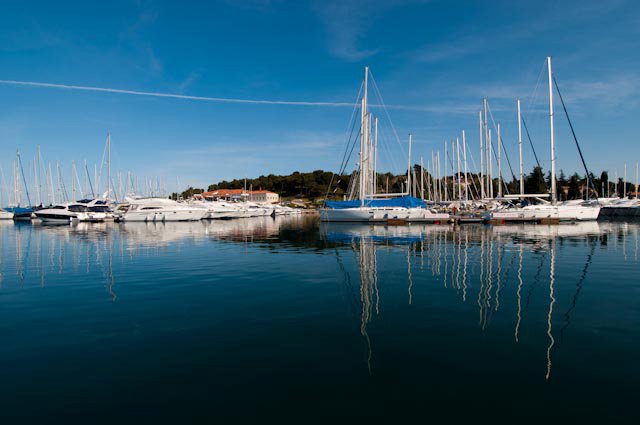
Sailing is an important part of Croatia's tourism offer, with the Istrian peninsula dotted with marinas - paddling in Vrsar marina.
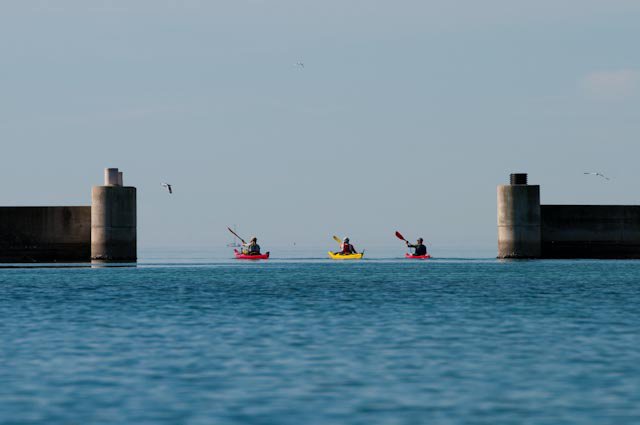
And back out again into the open sea.

The next tourist jewel is one of the gems of Coratian tourism - the peninsula walled stone town of Rovinj, which has more overnight stays than anywhere else in Croatia. But not many tourists arrive by kayak.

The timeless backstreets of one of the most beautiful towns on the Adriatic.
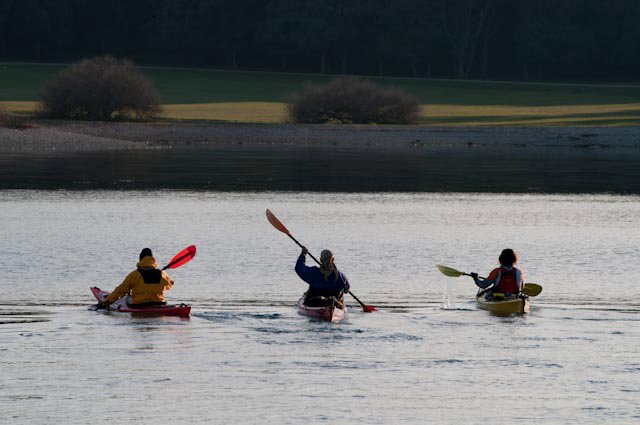
And from Rovinj to another national treasure - Brijuni National Park. Apart from its natural beauty, it is also home to some rather unusual animals, including zebras, an elephant and Shetland ponies.

Tito used Brijuni as his base during his rule, and he hosted more than 60 world leaders here, many of whom brought indigenous animals from their countries as gifts. I am not sure which is more unusual - the collection of living animals, or the stuffed animals who did not survive the relocation. Here are my impressions from a visit six years ago.
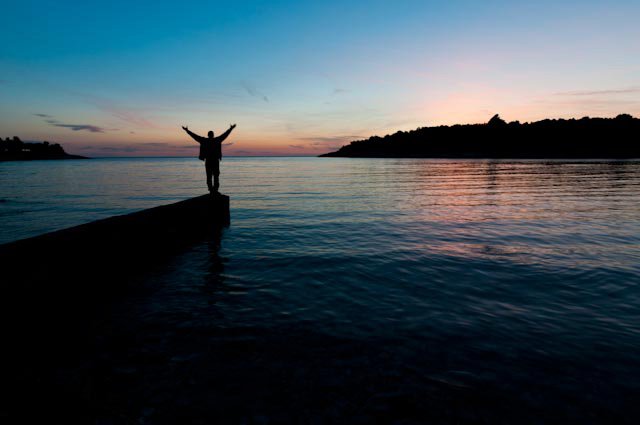
This being the Adriatic, most days end with sunsets like these to mark the end of another perfect day.
A key aspect of the Welcome project was to promote Croatian tourism, and the official website presents information on the main sites visited. Porec.
Rovinj and Brijuni.
Tune in tomorrow as Lacko kayaks to Pula, cycles to Pazin and then indulges in a little speleo-alpinism at Pazinska Jama.
You can see the entire project on the Welcome website, as well as much more of Luka Tambaca's stunning photography on the Welcome Facebook page.
You can follow TCN coverage of the whole journey on our dedicated page.
World's Biggest Welcome in Croatia: Day 1 - Savudrija to Porec (Kayak)
March 28, 2019 - Putting Croatian adventure tourism on the map, with the biggest welcome in the world. A little kayaking kicks off this incredible journey of adrenaline tourism along the Croatian coast.
It is 8 years since one of the finest tourism promotion ideas I have come across in my 17 years in Croatia took place.
An idea to celebrate the extraordinary potential of adventure tourism the length and breadth of the Croatian coast. As TCN explained in the introductory article yesterday, Daniel Lacko and his team's vision was to create a route which mapped out on GPS the world Welcome from Savudrija on the border with Slovenia, to Dubrovnik in the south, to showcase the different types of sporting challenge that could be enjoyed in this hospitable tourist nation.
As I said in my article yesterday, I had only just started writing online when the event took place, and I hadn't fully appreciated the level of achievement until now. Looking back at the media coverage, there was very little in English, and I thought it would be an opportunity to take a closer look at the potential of Croatia as an adventure tourism destination, through a day by day look at Daniel's incredible journey.
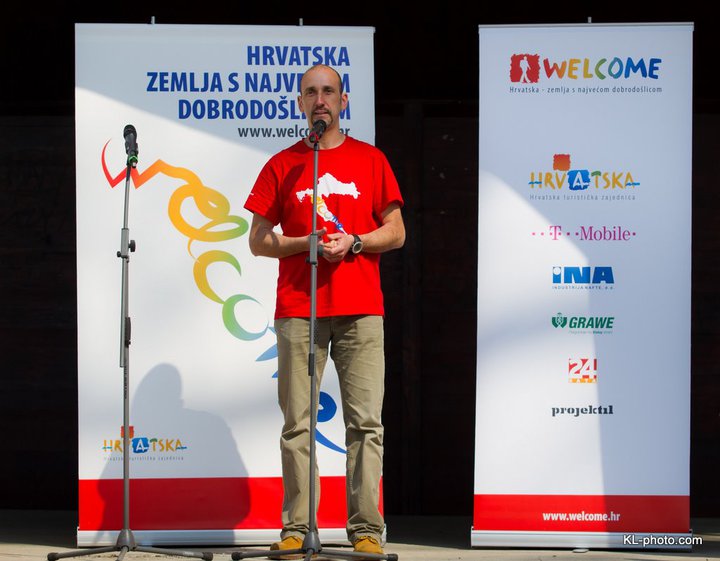
First, the formalities of the press conference to launch the event.
And then it was time to prepare for the 50-plus days ahead, with some 2,500 km to cover with a variety of disciplines.
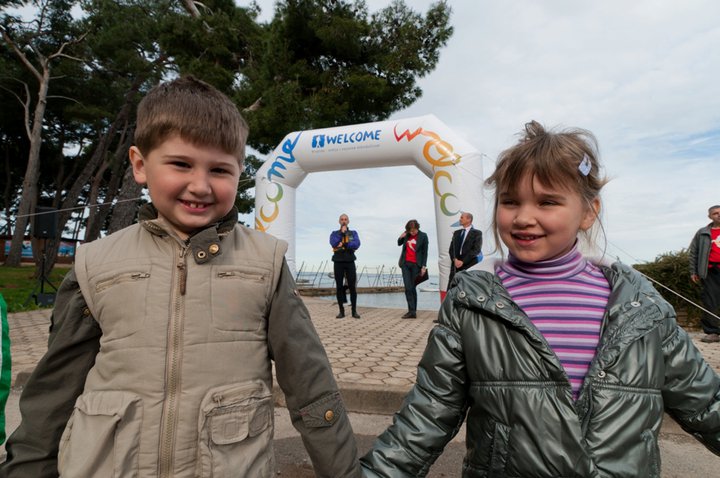
Lacko started in the very north of the Croatian coast, in Savudrija, perhaps better known recently for the fishing dispute in the Piran Bay. But back in 2011, it was the enthusiastic singing of the local kindergarten which got him started on his incredible journey.
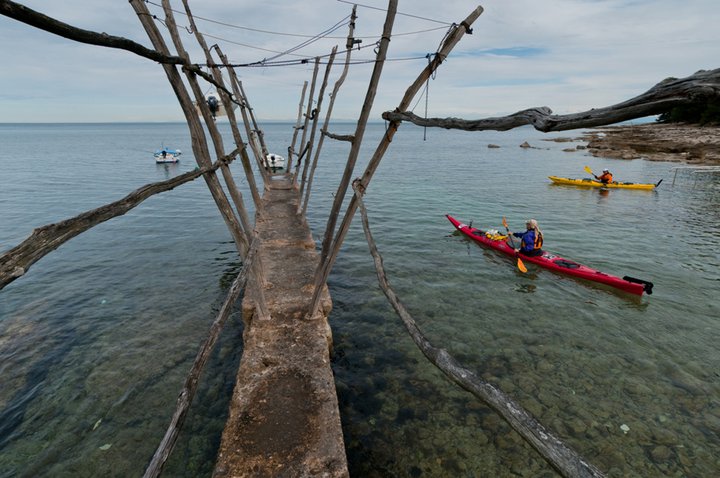
Kayak in the water, the journey had begun!

Hugging the Istrian coastline, a visit to Novigrad.

And a kayaking boy must eat. Time for lunch.
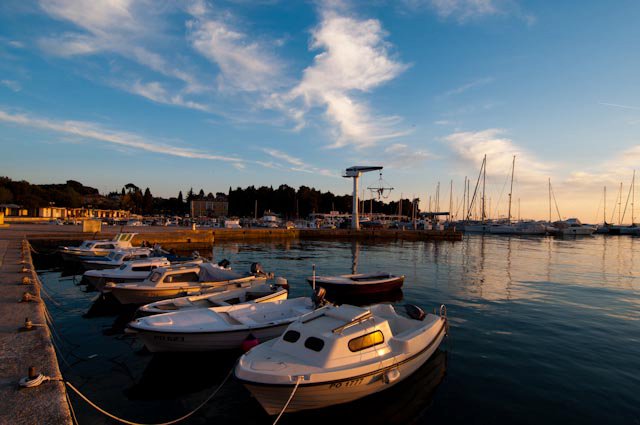
The first say was a 'leisurely' 35 kilometre kayak paddle from Savudrija to Porec, home to one of Croatia's 11 UNESCO World Heritage Sites.
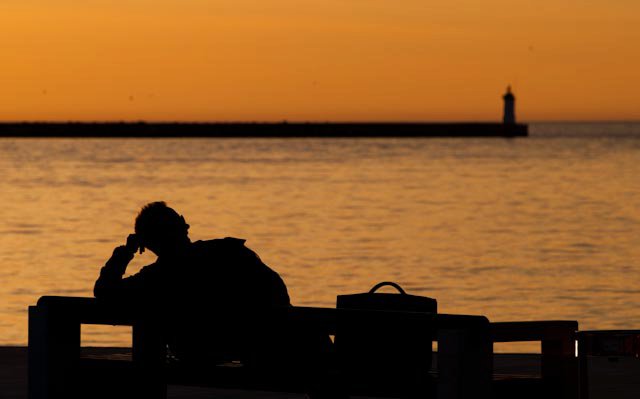
And a sunset to match the achievements of the day, one of many such sunsets which lay ahead, as the early April weather welcomed the World's Biggest Welcome to the Adriatic.
Day 1 of 52 - the distance and locations covered.
A key element of the project was tourist promotion, and the excellent Welcome website provides (and still provides) information of the main points of interest en route. On the first day, Savudrija and Porec.
You can see the entire project on the Welcome website, as well as much more of Luka Tambaca's stunning photography on the Welcome Facebook page.
Tune in for more kayaking exploits tomorrow, as Lacko negotiates 45 km from Porec to Rovinj to the magical Brijuni islands.
UNESCO World Heritage – Episcopal Complex of the Euphrasian Basilica in the Historic Centre of Poreč
This article will take a look at the Euphrasian Basilica in beautiful Poreč, which is listed on the prestigious UNESCO World Heritage List.
This basilica is extraordinary because it is a truly unique example of early Christian and Byzantine architecture and boasts some spectacular mosaics from that time. This is a complete surviving complex of this type, and this episcopal complex consists of the basilica, the atrium, the baptistery and the episcopal palace, which is an impressive example of religious architecture.
Poreč has a very long history and was initially the Roman town of Paretinum. The Euphrasian basilica is from the 6th century, and it remains one of the landmarks that makes Poreč recognisable to the world. It’s been on the UNESCO World Heritage List since back in 1997 based on its level of preservation and sheer beauty.
.jpg)
The history of Christianity in Poreč dates back to the 1st century after Christ (AD). At the end of the 2nd century, there was a Christian community under the bishop Mauro – they gathered secretly in his house which actually became the first church in the town. There lay a decorative fish mosaic which was an early Christian symbol.
.jpg)
The first bishop and clergy in Poreč all suffered martyrdom in the middle of the 3rd century, while in the year 313, the Christians were granted the freedom to worship in the Roman Empire. The former secret gathering place then became the very first public church.
At the same location, the first basilica was built during the second half of the 4th century, and that remains that of bishop Mauro and the other martyrs who moved to the early Christian cemetery. A larger basilica was constructed in the first half of the 5th century next to the existing basilica, and it was known as the Pre-Euphrasian basilica.
The floor mosaic of the temple area of the Pre-Euphrasian basilica was placed in the former sacristy. When Euphrasius first came to Poreč, he almost destroyed the old basilica in the mid-6th century, and built a magnificent three-nave basilica which still stands in Poreč today. At that time (543-554), the entire complex was made – the atrium, the bishops palace and the old baptistery.
The influence of Constantinople, the very centre of early Byzantine culture, is visible in the art and mosaics used in the construction and the decoration of the basilica. The floor of the basilica was covered with mosaics, and there were two layers of floor mosaics – the lower level belongs to the basilica from the fifth century, while the upper level is from the Euphrasian basilica of the sixth century.
.jpg)
The mosaics which decorated the interior are a valuable piece of heritage from the Byzantine era's art, and thanks to the floor mosaic and its preserved inscriptions, we can witness all the periods of its building and restoration even in the modern day. The basilica was built on an already existing Roman heritage site, meaning that various Roman artefacts can be found there, too.
The first church had three parallel rooms, and the central one was used as a basilica and even then, it enjoyed the status of a cathedral. In the 5th century, there were two basilicas in the south which were placed in front of the current Euphrasian basilica, while in the north, the walls and columns were kept standing. There was also a baptistery which remained in use, followed by another which came later on.
To understand why the Euphrasisus wanted to build such a spectacular basilica, it is essential to understand the fact that in the 6th century, Poreč was a small town in the then dying Roman Empire, and the emperor Justinian wanted to restore the Roman Empire's old glory. This is the time in which bishop Euphrasius started to build on the location of the ancient basilica and make this one of the biggest episcopal complexes of that time.
Shiny ''new'' Byzantine art created a unique piece of heritage on the Roman foundation. When Euphrasius came to Poreč, he found a town boasting a very long history, and he became the head of the well established Christian community which already had a few martyrs like St Mauro and St Eleturis under its belt by then.
Euphrasius began construction on the foundation of the previous church where he found early Christian mosaics decorated with images of fish with the mosaic donators' names inscribed on them, which helped in tracing the early Christian community in Poreč. There is one stone panel with an instruction written on it, from which we've been able to learn about the transfer of the body of St Mauro from a cemetery outside the town, to the place where the very first church originally once stood.
.jpg)
The new basilica, which was large in size, grew along with existing church objects. The construction of the basilica, the organisation of interior spaces, elements and ornaments, images on mosaics were all representing essential steps in the development of western art, influenced heavily by art from the east.
The entrance was formed one street before, and opposite the entrance, lies the baptistery – eight angles are from Pre-Euphrasian times, and the base is antiquity-era architecture. The structure of the wall and the wooden constructions of the roof are the work of local builders.
.jpg)
On the north-east angle of the basilica, there is a memorial chapel in which the layout is a bit different. The chapel, which was home to the relics of martyrs, has an oval atrium in front. The whole building underwent much needed restoration work in the 19th century.
The previous buildings on the site were construction material for the atrium, baptistery, and some parts of the basilica's walls. The organisational structure of the complex is confirmation of the whole concept which bishop Euphrasius initially had in mind, and this highlights just revolutionary his ideas really were for that time period. The rich decorations of the interior are additional evidence of the advanced ideas Euphrasius had, and represented Byzantine influence.
In front of the entrance to the basilica lies an atrium formed in the shape of a square, while the middle part of the atrium is an open space surrounded by arches - three arches on each side to be more specific. The eastern side of the atrium leads to the basilica and the western side to the baptistery. The central arch of these sides is elevated.
.jpg)
The arched-on columns and capitals were brought from Constantinople, just like with the one from the basilica. In the 16th and 17th centuries, during the great plague, the atrium and area around the church were used as a cemetery, with the atrium being rebuilt in the second half of the 19th century. Fragments of stone monuments from different periods of the Episcopal complex are displayed on its walls.
The baptistery is located in the western part of the Episcopal complex with the entrance facing the basilica. It was built in the 5th century and bishop Euphrasius had it restored and decorated in the 6th century. It was largely reconstructed in 1881 and then once again after the turn of the century, in 1935. The baptistery is an octagonal building with a hexagonal baptismal pool in the middle. It was surrounded with a sixteen-sided ambulatory, a sloping roof and three entrances.
The bell tower next to the Euphrasian basilica was built on the western side of the baptistery in 1522. Its 35 metres in height and provides a stunning view of the area. The bishops place is an integral part of the Episcopal complex, it is located in the northwestern part of the complex. On the first floor, there is a large ceremonial hall with a semi-circular apse on the northern side, it once used to be the audience hall, where the bishop received guests. Rights next to it on the left and the right sides there were once small chapels.
.jpg)
On the porch in front of the bishop’s palace lie some stone exhibits, capitals and various fragments of inscriptions in stone from previous basilicas in the area. The most important part of this lapidary is placed on the ground floor of the bishop’s palace. On the premises of the bishop’s palace, visitors can see different objects used by the church which span entire centuries.
The later built ciborium is part of the basilica from the 13th century, it presents as a masterpiece created seven centuries after Euphrasius' initial work. In 1277, a large marble ciborium was made, and its canopy was set on four columns which were taken from the original ciborium. The new canopy was covered with mosaics and displayed an image of the Annunciation. From this time, visitors are able to see visible differences in the composition and design when it comes to iconography and images of the Virgin Mary and the angels.
In the 13th century, the process of cultivating various pieces of cultural heritage one after the other took place once again – older pieces of heritage was blended into newer pieces. Early Byzantine capitals and columns hold the construction of the new gothic canopy covered with mosaics which clearly mark the end of one era and the beginning of a new one, a process which slowly removed the characteristics of Byzantine art and shows the turn towards the Venetian influence.
The Venetian influence can be seen at the basilica by turning to western cultural influence - this is noticeable in all the future interventions and additional work on the basilica and in Poreč.
.jpg)
The naves of the basilica share two rows of nine arcades and are connected to their pillars on the wall at their western and eastern ends. The arcade consists of gray marble poles that are based on well-shaped bases, and in the upper part, they end with the capitals over which they are imposed on round medals, in which there are embellished Euphrasius monograms.
The basilica and the whole complex have various capitals, rich perforations, and ornaments. There are several marble panels decorated with reliefs with different symbols like crosses, monograms, birds, deer, stylised horns...
.jpg)
In the arcades on the north side, the stucco was also painted in its original form. This visual glitter should also add the incrustations in the lower part of the apse. The pieces of multi-coloured marble and nacre are placed on the walls and make for creative ornaments. In the apse, there are also marble seats for the priests who close the marble slabs with dolphin reliefs on the side, while the centre of the semicircle is the place for the bishop's chair.
The walls of the Euphrasian basilica are one of the most valuable pieces of heritage as they boast various mosaics. Additionally, this is the place where iconographic innovation was applied for the very first time in the West. In the central part of the apse one can see the image of the Virgin Mary, which usually was the place for the image of Christ. The image shows the Virgin Mary sitting on the throne holding baby Jesus, who is wearing festive Roman clothes. On each side sit angels who are leading the groups coming to greet her. On the left side, three unnamed martyrs with wreaths in their hands and halos above their heads approach Mary, they appear like angels dressed in festive Roman clothes.
.jpg)
On the other side, behind the angel, stands St Mauro, depicted in the same way as the previous three martyrs, but with a printed name and a halo. This bishop and the saint of Poreč is leading a group of the contemporary people: the bishop Euphrasius holding the model of his basilica, the archdeacon Claudio (Euphrasius' brother) and the archdeacons son named Euphrasius, as well. Euphrasius had written his desire to renew the old basilica there.
The angels and the holy martyrs of the parade surround the Virgin Mary on the throne. Opposite to them, the living characters without halos are depicted in an individualised manner, as if they were portraits.
.jpg)
Other mosaics depict a strong Christian iconography too. The image of the Virgin Mary is the central point of Euphrasius basilica. She is of course holding baby Jesus, and this image presents two of the unarguably central figures in Christianity. The image of Annunciation in Christian iconography is the connection between Jesus and Mary. The image of Annunciation is based on Luke’s gospel, and such images can be traced as far back as the 4th century in catacombs, while this iconography became more developed in the 5th century, as is visible in the Poreč basilica.
In the 6th century, in the time of Justinian and Byzantine-influenced art, the Virgin Mary wore the veil which symbolised her virginity. The Virgin Mary is pictured sitting on the throne whose columns blend with the basilica's columns, which signifies the connection of the Virgin Mary to the church.
.jpg)
Mary holds a rove while an angel greets her. The angel is turned in a manner where half of its profile can be seen, which was specific for the art of the time, shown as if in movement, wearing bright clothes. Opposite to the image of the Annunciation sits the image of the visit of the Virgin Mary to her cousin Elizabeth. In the middle part of the apse between these two images from the Virgin Mary's life, there is an image of Saint Zachary, an angel, and John the Baptist. In the lower part of the triumphal arch, there are thirteen round medallions.
In the middle section, there is the image of Christ shown as Agnus Dei, while on each side there are six saints pictured, along with their respective names. On the top part of the apse, there is an image of the apostles with Christ in the middle – Christ is presented as a young ruler who rules over the world. The Apostles are surrounding Christ in this image, and have their names written around their halos. In the higher parts of the side apse, there are fragments of mosaics boasting almost identical images – the large figure of Christ comes down from the clouds and is seen placing bay leaves on the heads of two martyrs.
Mosaics of the sort weren’t just placed in the interior of the basilica, but were placed on the outside too. Unfortunately, they weren’t preserved and were covered over when restoration work took place periodically. They originally showcased an image of Christ sitting on the globe, along with his Apostles.
With this extremely rich array of well preserved heritage, the Euphrasian Basilica is somewhere you must visit! Until you manage to pay it a visit, you can check out a virtual tour by clicking here (make sure you have Flash enabled!).
.jpg)
SOURCE(S) (text and photos): Tourist Board Poreč, Istra Culture, UNESCO
200 Million Kuna Worth of Investments Planned for Istria's Ports
Investment in Croatia continues despite problematic red tape, and thanks to EU funds (among others), Istria County is set to see a huge cash injection for their numerous ports.
As Poslovni Dnevnik writes on the 4th of March, 2019, Istria County is the founder of five port authorities: Pula Port Authority, Rovinj Port Authority, Rabac Port Authority, Poreč Port Authority and Umag-Novigrad Port Authority, which are expecting big investments this year, according to a report from Glas Istre.
In Pula, the completion of the new 130-metre-long coastline is expected, which will surely contribute to the further overall growth of maritime traffic in the busy Port of Pula. The construction of the new operational coast/shoreline is a project which has been being carried out in several phases, and the latter part of it is worth 3.5 million kuna. Another significant move is that at the end of this year, the design of the passenger terminal project in Pula should begin.
In addition to the ''doing up'' of Pula's coastline, Pula Port Authority is also expecting several other projects to begin, including the replacement of pontoon at Bunarina, the continuation of the promenade towards Veli Vrh, the redoing of the coastline in Fažana, as well as the harbour in Krnica, and works on the beloved Brijuni island which stand at about seven million kuna.
In 2019, Rovinj Port Administration plans to build the San Pelagio communal port, estimated at a value of 32 million kuna, in which Istria County, the City of Rovinj and Rovinj Port Authority will jointly participate.
Significant investments, announced by county prefect Flego, are also expected in the area of the Port of Rabac. The plan is to reconstruct the Trget communal barges, the value of which is estimated at 13.3 million kuna.
Other projects in the works are the construction of a primary breakwater in the port of Rabac, estimated at 72 million kuna, for which a financing model is currently being sought, while the project of Brestov Port, worth 23.7 million kuna, is set to be financed through European Union funds.
Poreč Port Authority is also expecting a number of projects, and the most significant of them all is extension is the existing naval structure in Vrsar Port, which serves as a home for fishing vessels, amounting to 10.5 million kuna. With the extension of the existing area, fifteen brand bew anchorage sites will be provided, meeting the needs of Vrsar Port, as one of the most active fishing centres on the western coast of Istria.
In addition, progress is being made on works on the Barbaran breakwater, through with Poreč Port Authority continues to invest in the Poreč aquatorium. This is the most important investment this year in Poreč, worth 4.8 million kuna, which is financed from the aforementioned port authority's own funds, Istria County and the Ministry of Maritime Affairs, Transport and Infrastructure.
A welcome 5.1 million kuna was allocated by the EU Maritime and Fisheries Fund to the Umag-Novigrad Port Authority, for the demolition of the old pier and the construction of a new one in Savudrija harbour, seventeen new lighting posts, the introduction of video surveillance cameras, and the installation of an ''eco-island'' for waste separation for local fishermen.
In addition to all of the above, another major project is under preparation for the construction of the new Dajla-Belveder port, and all the necessary permits to get the green light are now underway.
The start of construction is planned for this year and will continue through 2020. The construction of the port will provide sixty communal berths, a landing place for fishing vessels and an appropriate operational shoreline for small boat excursions. The project value amounts to 24.3 million kuna, with the funds provided by the Ministry of Maritime Affairs, Transport and Infrastructure, Istria County, the City of Novigrad, and the Umag-Novigrad Port Authority.
Make sure to stay up to date with investment in Croatia, doing business in Croatia, and the overall business and investment climate by following our dedicated business page.
Zagreb and Poreč to Get Large New Shopping Outlets in 2019
Good news for retail therapy lovers and job seekers alike as both Zagreb and the Istrian city of Poreč are due to get new big shopping centres and a wave of new employment opportunities that go with it.
As Korana Sutlic/Barbara Ban/Novac writes on the 2nd of February, 2019, the current plan for Poreč's up and coming brand new outlet is to have it completed entirely by this summer, it will be located at the entrance to the popular Istrian city. It will be the first such shopping centre in the second largest city in Istria to accommodate shops such as BIPA, C & A, CCC, Deichmann, Galileo, Hervis, Müller, New Yorker, Tedi and Svijet Media.
The investor and owner of the project is the company AM PS Delta Nekretnine d.o.o., which has already built a shopping center in Pula - Pula City Mall. Otherwise, the company AM PS Delta Real Estate Ltd., a member of the Croatian subsidiary of MID Bau Real Estate Ltd., is one of the leading developers on the domestic market, and along with the Pula project, they so far have realised the Garden Mall project in Zagreb, TC Koprivnica, STC Osijek, STC Sisak , STC Valpovo, and STC Umag.
''Works began several months ago, and the completion is scheduled for June this year. Poreč will get its well-deserved shopping and entertainment centre, conceptually conceived as a retail park, and every store will have its own entrance. The retail area of the centre will be around 8,379 square metres in size, which will also make it the largest shopping center in Poreč, and in just a few days the final version of its layout will be known,'' they say from Poreč's city administration upon welcoming this large investment.
Along with the new shopping centre, new jobs will of course come as part of the greater package, which is naturally a more than welcome move for the local economy.
Projects in Zagreb
In addition, this June will see a brand new retail park open at the western part of the Arena Center in Zagreb, on a surface of 8,000 square metres, the content of which will mainly be shops which need large spaces. In the Zagreb district of Špansko, a brand new Z centre will be constructed, which will result in an impressive 60,000 square metre shopping centre, along with stand-alone facilities - McDonald's and Lidl.
The new Zagreb retail centre will boast a square, a multiplex cinema, as well as numerous shops, cafes and restaurants. The completion of Zagreb's Z centre's construction is planned for the end of this year. The completion of the reconstruction of Branimir Centre is also expected this spring.
Make sure to stay up to date by following our dedicated lifestyle and business pages for much more. If it's just Zagreb you're interest in, give Total Zagreb a follow.
Click here for the original article by Korana Sutlic and Barbara Ban for Novac.jutarnji.hr
Poreč and Istria to Host Ironman 5150 2019 and 2020 Races
Plava Laguna, one of the biggest hospitality and tourism companies in Croatia, Istria County, Poreč town and Funtana municipalities, as well as their tourist boards, decided to support the new top event coming to Poreč this spring: Ironman 5150 2019 and 2020 races will be held in Istria!
HRTurizam writes about World Triathlon Corporation, the owner of the license for the event, signing the contract with Plava Laguna for the two years. 5150 race means that it's an Olympic triathlon, meaning 1.5 kilometres of swimming, 40 kilometres of cycling and 10 kilometres running. The race in 2019 will be held on May 5th, between Funtana and Poreč.
"We're thrilled that we brought the Triathlon 5150 series race to this wonderful part of Croatia, and we're sure that the athletes from the entire EMEA region will have a great event, but also an amazing weekend in Poreč", Stefan Petschnig, director of Ironman Europe, Middle East and Asia said. He added that some athletes might be intimidated by the prospect of participating in an full Ironman or Ironman 70.3 race, but 5150 race is much more accessible to athletes of varying, albeit still majestic, abilities.
Race director Goran Vrus said that he expects more than 500 participants in the race, and more than 1500 people coming to Poreč for support with them. In addition to Ithe ironman 5150 2019 Poreč race, Ironkids and Irongirl are planned to take place on August 6th, 2019.
HEP Croatia Cup: Croatia Handball Defeats Italy, Wins Tournament
After defeating Montenegro 34:22 on Friday, Croatia overcame Italy in their second match of the HEP Croatia Cup 28:20.
Plava Laguna to Invest 300 Million Euros in Tourist Facilities in 2019
This year, the Plava Laguna tourism company has realised the most significant capital budget in its history with half a billion kuna. In 2019, it will continue to invest heavily, with about 300 million kuna to be spent in destinations such as Poreč, Umag and Rijeka, announced the company on Monday, reports Poslovni.hr on December 17, 2018.
The company emphasised this year's investments in the Park Resort in Poreč worth 245 million kuna. It is a family resort consisting of 309 accommodation units, including 154 hotel rooms and suites, 91 garden suites, 43 apartments and 21 villas.
In Umag, the company invested in the complete reconstruction of the Stella Maris camp, which was a project worth 84 million kuna, and in Garden Suites & Rooms Sol Umag in the amount of 35 million kuna.
“Key investments for the next year include the construction of a new office building in Poreč and a thorough reconstruction of a campsite in Savudrija, which includes new, additional facilities. The estimated value of the investment in the camp is 46 million kuna. That will be the largest investment of Plava Luga in Umag in 2019,” announced the company. It added that Camping Savudrija would become a camp for families and couples with an "active vacation" offering. Mobile homes and glamping tents will be introduced.
The most significant part of the investment is the construction of a new pool complex that will improve the level of service and quality and significantly extend the tourist season. Also, with this investment, the camp will get an entirely new profile and provide guests with a remarkable destination experience as well as with conditions for a great vacation.
Next year, Plava Laguna will also invest in the Park Umag campsite, in the total amount of 6.2 million kuna.
Also, Plava Laguna will invest in an office building in Poreč, which will be located at the Facinka business zone at the very entrance to the town. This investment will amount to 86 million kuna. The company will also invest in six additional villas in the Bellevue facility at Plava Resort.
In Poreč, Plava Laguna will also invest in the camping segment (Puntica, Zelena Laguna, Bijela Uvala and Ulika), and there will be an intensified investment in extending and modernising the existing capacities for the accommodation of workers in Poreč and Umag.
"Looking at 2018 and 2019, Plava Laguna's investments will amount to more than 750 million kuna, which is the highest figure in the company's recent history,” concluded Plava Laguna.
More news on Croatia’s tourism can be found in our Travel section.
Translated from Poslovni.hr.
Property in Croatia: House and Apartment Prices Fluctuate
Questions about property in Croatia are common, and while the prices vary dramatically in various regions of the country, with places like Split and Dubrovnik typically dominating, there have been some significant fluctuations.
As Novac.hr/Jutarnji/Iva Novak writes on the 15th of December, 2018, Crozilla.com's data on property in Croatia showed that average prices of advertised houses rose by 0.8 percent in November. When comparing them to apartments, which are still more expensive than houses, the difference was almost 21 percent.
Dubrovnik, with a difference of 10 percent, and Poreč with 2.5 percent, remained, as they did in previous months, rare cities in which houses were more expensive than apartments. The biggest monthly increase was recorded in Dubrovnik, where prices rose 5.8 percent, so the value per square metre in a house, with the price of a garden included, rose to 4,145 euros.
For a square metre of a house in Poreč, an average of 1,911 euros was requested, which is 0.4 percent more than it was during the previous month. The biggest difference in prices during November posted on Crozilla.com in Bjelovar, where houses were more than 44 percent cheaper than apartments, and then in Osijek where the difference was 39 percent, followed by Varaždin, at 36.3 percent.
The average advertised price of houses in Bjelovar was only 434 euros per square metre, which is 0.9 percent less than the month before. In Osijek, their value rose by 1.2 percent, while the price per square metre was only 587 euros. The data also showed that houses in Varaždin increased by 0.6 percent on average, and 713 euros was being asked per square metre.
In Zagreb, house prices were almost 34 percent lower than apartment prices, and the price per square metre advertised was 1,261 euros on average, representing a monthly increase of 0.7 percent. In Slavonski Brod, a 634 euros per square metre of a house was demanded, which is almost 21 percent less than the price of the apartment there.
The value of houses fell by 0.3 percent on the monthly level, as well as in Senj, where they were 25 percent cheaper than apartments, and their average cost was 1,195 euros per square metre. Lower monthly value in the amount of 0.9 percent was recorded in Umag, where 1,877 euros was being requested per square metre for a house, which is 7.8 percent less than the average price of apartments there.
In Opatija, house prices fell by 1.1 percent, and the value of their ''square metres'' dropped to 2,216 euros, which is almost 25 percent less than the advertised apartment price. There was a similar difference in the prices of houses and flats in Šibenik, where the average square metre price in a house averaged 1,529 euros, which is 0.1 percent less than it was during the previous month.
In Zadar, however, houses were about 23 percent cheaper than apartments.
Their monthly values increased by 0.5 percent in November, and the price per square metre, with a garden included, stood at 1,698 euros. The prices of houses in Split rose by 3.8 percent on a monthly basis and reached 2,417 euros per square metre. Housing there during November was about 15 percent cheaper than apartments there were, and such a difference in prices was also recorded in Rijeka, where 1,229 euros per square metre were being demanded, 0.8 percent more than the previous month.
In Pula, according to Crozilla.com, prices on a monthly basis increased by 0.3 percent, so the price per square metre of a house demanded 1,459 euros on average, which is 13.1 percent less than the price of the apartment.
Make sure to follow our dedicated lifestyle page for more information on property in Croatia and much more.
Click here for the original article by Iva Novak for Novac.hr/Jutarnji
Poreč to Host Another Great Sporting Event: 2020 European Judo Championships!
During the European Judo Championships for U23s in Hungary, a meeting was held at the highest level of the Croatian Judo Federation and the European Judo Union. The result of the months-long agreement is confirmation that the European Judo Championship for U23s will be held in the City of Poreč in 2020!

